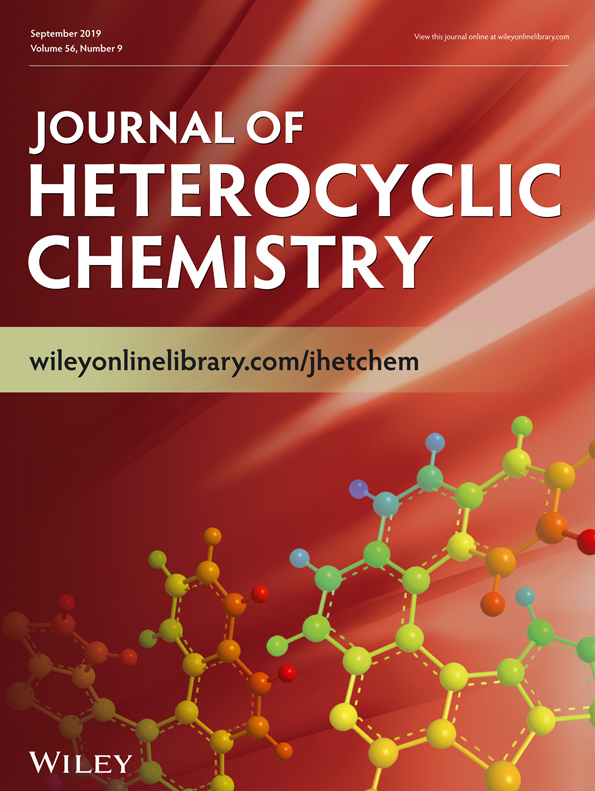An Unprecedented Synthesis of 3,3-Disubstituted Isochroman-1,4-diones Using Nitrones as Oxygen Atom Donors
Vidya Sathi
Department of Chemistry, University of Kerala, Kariavattom Campus, Thiruvananthapuram, 695581 Kerala, India
Search for more papers by this authorCorresponding Author
Ani Deepthi
Department of Chemistry, University of Kerala, Kariavattom Campus, Thiruvananthapuram, 695581 Kerala, India
E-mail: [email protected]Search for more papers by this authorNoble V. Thomas
Department of Chemistry, University of Kerala, Kariavattom Campus, Thiruvananthapuram, 695581 Kerala, India
Search for more papers by this authorVidya Sathi
Department of Chemistry, University of Kerala, Kariavattom Campus, Thiruvananthapuram, 695581 Kerala, India
Search for more papers by this authorCorresponding Author
Ani Deepthi
Department of Chemistry, University of Kerala, Kariavattom Campus, Thiruvananthapuram, 695581 Kerala, India
E-mail: [email protected]Search for more papers by this authorNoble V. Thomas
Department of Chemistry, University of Kerala, Kariavattom Campus, Thiruvananthapuram, 695581 Kerala, India
Search for more papers by this authorAbstract
A one-pot reaction of ninhydrin, N-methyl-C-phenyl nitrone, and secondary amine leading to the unprecedented synthesis of 3,3-disubstituted isochroman-1,4-diones is described here. In this reaction, nitrone acts as an oxygen atom donor producing an imine as a side product. The mild reaction conditions, the flexibility of the secondary amines that can be used, the novelty of the product, and the good yields are the highlights of this reaction.
Supporting Information
| Filename | Description |
|---|---|
| jhet3619-sup-0001-SI.docWord document, 1.3 MB |
Data S1. Supporting information |
Please note: The publisher is not responsible for the content or functionality of any supporting information supplied by the authors. Any queries (other than missing content) should be directed to the corresponding author for the article.
References and Notes
- 1Trisuwan, K.; Rukachaisirikul, V.; Sukpondma, Y.; Phongpaichit, S.; Preedanon, S.; Sakayaroj, J. Tetrahedron 2010, 66, 4484.
- 2Tobe, M.; Tashiro, T.; Sasaki, M.; Takikawa, H. Tetrahedron 2007, 63, 9333.
- 3Bianchi, A. D.; Blanco, E. N.; Carrillo, N.; Kaufman, S. T. J Agric Food Chem 2004, 52, 1923.
- 4Sarkar, S.; Sultana, S.; Indukurl, K.; Unnava, R.; Saikia, K. A. Synthesis 2016, 48, 1727.
- 5Tomás-Mendivil, E.; Starck, J.; Ortuno, C. J.; Michelet, V. Org Lett 2015, 17, 6126.
- 6Lakshminarayana, N.; Prasad, Y. R.; Gharat, L.; Thomas, A.; Ravikumar, P.; Narayanan, S.; Srinivasan, V. C.; Gopalan, B. Eur J Med Chem 2009, 44, 3147.
- 7Gowrisankar, S.; Lee, S. H.; Kim, N. J. Bull Korean Chem Soc 2007, 28, 2501.
- 8Barbier, J.; Jansen, R.; Irschik, H.; Benson, S.; Gerth, K.; Böhlendorf, B.; Höfle, G.; Reichenbach, H.; Wegner, J.; Zeilinger, C.; Kirschning, A.; Müller, R. Angew Chem Int Ed 2012, 51, 1256.
- 9Ma, G.-H.; Jiang, B.; Tu, X. J.; Ning, Y.; Tu, S.-J.; Li, G. Org Lett 2014, 16, 4504.
- 10Crespi, S.; Jäger, S.; König, B.; Fagnoni, M. Eur J Org Chem 2017, 2017, 2147.
- 11Pinchuk, I. V.; Bressollier, P.; Sorokulova, I. B.; Verneuil, B.; Urdaci, M. C. Res Microbiol 2002, 153, 269.
- 12Mandal, S. K.; Roy, S. C. Tetrahedron 2008, 64, 11050.
- 13Knott, E. B. J Chem Soc 1963, 402.
- 14Matsui, M.; Sugimura, Y.; Yamashita, K.; Mori, K.; Ogawa, T. Agr Biol Chem 1968, 32, 492.
- 15Zhu, S. T.; Chen, P. J.; Xu, H. M. Chem A Eur J 2013, 19, 865.
- 16Barcia, J. C.; Cruces, J.; Estévez, J. C.; Estévez, R. J.; Castedo, L. Tetrahedron Lett 2002, 43, 5141.
- 17Prasad, R. K.; Nagaraju, C. Org Lett 2013, 15, 2778.
- 18Borthwick, J. L.; Wilson, S. Eur J Clin Pharmacol 1984, 26, 475.
- 19Satomura, Y.; Sato, S. Agr Biol Chem 1965, 29, 337.
- 20Bogevig, A.; Gothelf, V. K.; Jorgensen, A. K. Chem A Eur J 2002, 8, 5652.
10.1002/1521-3765(20021216)8:24<5652::AID-CHEM5652>3.0.CO;2-J CAS PubMed Web of Science® Google Scholar
- 21(a) Sivan, A.; Deepthi, A. Tetrahedron Lett 2014, 55, 1890; (b) Balachandran, L. A.; Sathi, V.; Deepthi, A.; Suneesh, C. V. ARKIVOC 2016, (v), 327.
- 22Ziarani, M. G.; Lashgari, N.; Azimian, F.; Kruger, G. H.; Gholamzadeh, P. Arkivoc 2015, (vi), 1.
- 23Repeated attempts to crystallize compound 6 as well as its hydrazone derivative (compound 28 in SI) failed and both compounds were found to be non-crystalline. Additionally, attempts for crystallization of the hydrazone derivative in solvents like dichloromethane-methanol led to the recovery of 6 due to hydrolysis.
- 24Valizadeh, H.; Dinparast, L. Heteroatom Chem 2009, 20, 177.
- 25Poliakov, D.; Shevchenko, I. Eur J Org Chem 2007, 2007, 2055.
- 26The compound 6 was found to be stable on heating to 80 °C. in benzene and its 1H NMR was recorded in C6D6. No other structural isomer was detected. The compound existed in the closed isochroman cage form in CDCl3, C6D6 and DMSO-d6.
- 27Matsui, K.; Shibuya, M.; Yamamoto, Y. ACS Catal 2015, 5, 6468.
- 28Xiao, J.; Li, X. Angew Chem Int Ed 2011, 50, 7226.
- 29Torre, A.; Kaiser, D.; Maulide, N. J Am Chem Soc 2017, 139, 6578.
- 30Yamashita, K.; Yamamoto, Y.; Nishiyama, H. J Am Chem Soc 2012, 134, 7660.




